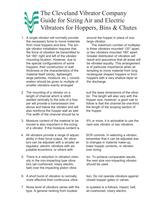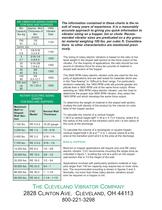
Catalog excerpts

1. A single vibrator will normally provide the necessary force to move materials from most hoppers and bins. The sin- gle vibrator installation requires that the force of vibration be transmitted to full 180 right and left of the vibrator mounting location. However, due to the special configurations of some hoppers, their construction or wall thickness or the characteristics of the material itself (sticky, lightweight, large particles, moisture, etc.), consid-eration should be given to multiple of smaller vibrators evenly arranged around the hopper in place of one large vibrator. The maximum number of multiples is three vibrators mounted 120а apart, or two vibrators mounted 180 apart. Greater distribution of vibration will result and assurance that all areas will be vibrated equally. This arrangement is of particular importance when at-tempting to move material from long rectangular shaped hoppers or from hoppers with a very shallow taper at the discharge. 2. The mounting of a vibrator on a length of channel which is stitch welded vertically to the side of a hop- per will provide a transmission line above and below the vibrator and will also reinforce the hopper wall as well. The width of the channel should be to suit the base dimensions of the vibra-tor. The length will also vary with the hopper size, however, a good rule to follow is that the channel be one-third the length of the scoping section of the hopper. 3. Moisture content of the material to be moved is also important in the sizing of a vibrator. If the moisture content is 6% or more, it is advisable to use the next size vibrator or two vibrators. 4. All vibrators provide a range of adjust-ability in their force output. Air vibra-tors can be adjusted with a simpler air regulator; electric vibrators with ad- justable eccentrics; or others with SCR controls. In selecting a vibrator, remember that it can be adjusted due to changes in material make-up, lower hopper contents, or vibrator over sizing. 5. There is a reduction in vibration inten-sity in the non-impacting type vibra-tors (air-cushioned, rotary electric, ball) over the impacting piston vibra-tor. To achieve comparable results, the next size non-impacting vibrator should be used. 6. A short burst of vibration is normally more effective than continuous vibra-tion. Do not operate vibrators against closed hopper gates or valves. 7. Noise level of vibrators varies with the type. A general ranking from loudest to quietest is a follows: impact, ball, air-cushioned, rotary electric. >
Open the catalog to page 1
AIR VIBRATOR SIZING CHARTS FOR BINS AND HOPPERS > Bin Capacity lbs./kg Approx. Skin Thickness of Bin in/mm VMS Vibrator Size 700 91 1/8 3.2 1125 ton/m. ton 1 0.9 1/8-3/16 3.2-4.8 1150 3 2.7 3/16-1/4 4.8-6.4 1200 The sizing of rotary electric vibrators is based on the ratio of ma- terial weight in the sloped wall section to the force output of the vibrator. For the majority of applications, the ratio should be one pound of vibratory force for every ten pounds of material in sloped wall section of the hopper. The 3600 RPM rotary electric vibrator units are used for the ma- jority of...
Open the catalog to page 2All Cleveland Vibrator catalogs and technical brochures
-
CVT-P-S Turbine Vibrators
2 Pages
-
Vibratory Feeder Catalog
12 Pages
-
Vibratory Screening Catalog
12 Pages
-
Vibratory Tables Catalog
8 Pages
-
Bolt Torque
2 Pages
-
Mounting Manual
1 Pages
-
Accessories
3 Pages
-
DC Truck Vibrators
2 Pages
-
Specialty Products
2 Pages
Archived catalogs
-
industrial vibrators
20 Pages











